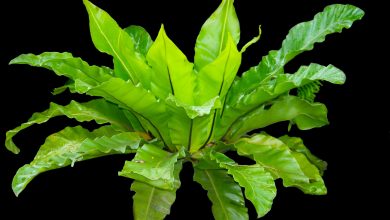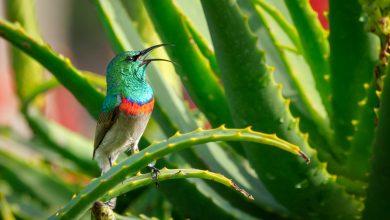11 Best Small House Plants

Having living plants in your house is not only an attractive way to show off your style, but it’s also a helpful way to stay healthy. When you breathe, you inhale oxygen into your body and release carbon dioxide. Plants do the reverse of that, absorbing carbon dioxide and producing oxygen.
House plants not only help you breathe, but they can fend off illness as well. Plants introduce moisture into the atmosphere, which can increase the humidity in your house. According to a study from the Agricultural University of Norway, house plants reduce dry skin, coughs, sore throats, and the common cold.
Your house plants also help clean the air. Small amounts of carbon monoxide and other toxic materials can be erased from your home by a plant’s leaves alone.
Befitting of all these benefits, we have a jam-packed list of 11 different small house plants to consider in your home.

1. Aloe Plants
Aloe
Level of Care: Beginner
Sunlight: Full sun
Water: Use a spray bottle to water it two to three times per week
Soil: As with all succulents, aloe plants require well-draining soil
Aloe plants combine ease of use with attractive interest – the perfect combination for a small house plant.
You are probably familiar with aloe vera, which soothes burned skin. But there are a variety of aloe plants you can choose from depending on your style. Lace aloe is one of the more interesting varieties, featuring small white bumps that lend themselves to the lacey look of the plant from a distance.

2. Anthurium
Anthurium andraeanum
Level of Care: Intermediate
Sunlight: Full sun to partial shade
Water: Every other day
Soil: Anthuriums are not picky about soil
A perennial plant and one of the highlights of landscapes throughout the Hawaiian Islands, anthurium plants are uniquely striking. Also known as the flamingo plant, anthuriums feature a waxy sheen that almost doesn’t appear real.
Anthuriums can be easily identified by heart-shaped leaves growing at the end of a long, narrow stem, which can grow to a height of 20 inches. Coming out of the center is a yellow flower known as the spadix. The petals of anthuriums can range from deep pink to bright red and can be a standout addition to your home’s décor.
As far as toxicity, anthuriums are unfortunately one of the more toxic plants, as every part of the plant is poisonous. Keep this one out of the reach of pets or kids.

3. Asparagus Fern
Asparagus aethiopicus
Level of Care: Beginner
Sunlight: Bright light to low light
Water: Water two times per week
Soil: Asparagus ferns are not picky about soil, but you can supplement with a balanced fertilizer during the growing season
The foxtail asparagus fern is a distinctively attractive plant featuring a soft and delicate appearance. In reality, the tips of the plant’s leaves are sharp and shouldn’t be touched. Asparagus ferns are also toxic to both pets and humans, so consider a hanging basket if you have kids or pets that may want to get a taste. But once you get past the sharp needles and toxicity, the asparagus fern is a uniquely beautiful addition to any space.

4. Cactus Plants
Cactaceae
Level of Care: Beginner
Sunlight: Full sun from a south-facing window ideally
Water: Once a week, if your pot has draining soil, and if not, just sparsely to prevent the roots from rotting
Soil: Well-draining soil is necessary; look for a specific cactus potting mix
There are many different cactus plants you can choose from. One of the more recognizable versions is the bunny ears cactus, which more closely resemble Mickey Mouse ears.
Cactus plants provide you with the opportunity to mix and match different styles to create a fun, southwest-style vibe to your indoor spaces. Not only do cactus plants bring an intriguing new look to your home, they’re also incredibly easy to care for. As with all succulent plants, cacti are incredibly drought-tolerant and will start to diminish in appearance if you water too frequently.

5. Calathea
Calathea
Level of Care: Beginner
Sunlight: Indirect sun, as direct sun will fade the plant’s color
Water: Keep the soil moist – not too wet and not too dry
Soil: Choose a potting mix that is one part perlite and two parts peat
The family of Calathea plants provides a variety of options to add new and exciting patterns to your space. Some options you can take a closer look at are the Calathea ornata, orbifolia, rattlesnake plant, eternal flame, peacock plant, and zebra plant. In total, there are over 300 varieties of Calatheas.
Each of these Calatheas is unique in its own way, and you’re likely to find at least one that vibes with your style.
Calathea plants are also easily propagated, so once you have one, you can grow many more to decorate the inside and outside of your living space.

6. Echeveria
Echeveria
Level of Care: Beginner
Sunlight: Not picky about the amount of sun it gets
Water: Water sparingly and do not let water settle in the leaves
Soil: Well-draining soil, look for a specific succulent mix
If you are a fan of succulents, it is highly likely that you are a fan of echeveria plants. Echeverias take the typical looking succulent and crank up the volume with stunningly attractive colors.
Succulents are one of the most tolerant plants when it comes to the amount of attention you need to give them. If you notice the pot is bone dry, you should add some water. But otherwise, an echeveria will grow without any trouble.

7. Gardenia
Gardenia jasminoides
Level of Care: Expert
Sunlight: As much as you can provide
Water: Water enough to keep the soil damp at all times
Soil: Acidic soil is preferred, with a pH of 5.0 to 6.0
The key to the gardenia plant is getting it to flower. That is where the “expert” level of care comes in. This plant needs six to eight hours of bursting bright sunlight to produce the intoxicating smell of its flowers.
The flower not only smells marvelous, but looks incredible too, looking impossibly soft and perfectly white with layers of petals resembling the bloom of a rose.
But even if it doesn’t flower, the plant still provides interest with large oval leaves, providing a green element to your space. To give your plant the best chance of flowering, add additional nutrients to the gardenia’s soil. Adding a layer of compost to the soil would be ideal, but adding peat moss can also help.
Gardenia plants also thrive with high levels of humidity. To give the plant what it desires without making your house a sauna, use a spray bottle to mist the plant daily. And if you want to provide the ultimate level of care to really coax that flower out, try keeping the temperature between 65 and 70 degrees during the day and 60 to 65 degrees at night.

8. Jade Plant
Crassula
Level of Care: Beginner
Sunlight: Full sun works best for jade plants; try putting them near a south-facing window
Water: Jade plants are succulents and are exceptional at retaining water, so avoid overwatering
Soil: Look for a potting soil specifically for succulents
Jade plants are among the most popular house plants as they are easy to maintain and small enough not to take up a lot of space but attractive enough to provide consistent interest.
If you have a young jade plant, treat it with a nitrogen-rich blend of fertilizer. Mature plants should get a balanced fertilizer during the growing season.
You will not lack for choice if you decide to add a jade plant to your décor, as there are over 1400 different varieties worldwide. Jades are especially popular choices for hybrid species, and new types are being added each year.

9. Snake Plant
Dracaena trifasciata
Level of Care: Beginner
Sunlight: Indirect light is manageable, but medium to bright light is ideal
Water: Only water once the soil has completely dried out ,and do not water the leaves
Soil: Well-draining soil is necessary, and a mixture without any soil works best
Snake plants are perfect for the person that is only interested in adding a stylish new element to their home and is less concerned about actually caring for the plant. These plants are incredibly resilient and do not require more than the cursory watering now and then.
If you decide you want to expand your gardening horizons, snake plants are also easily propagated using the division process. Simply remove a leaf and replace it in a new pot, pushing it down one inch into the soil.

10. Spider Plant
Chlorophytum comosum
Level of Care: Beginner
Sunlight: Indirect sun
Water: Let the plant dry a bit before rewetting the soil to prevent overwatering
Soil: Well-draining soil – a typical potting mix should work fine
Like the snake plant, the spider plant is a go-to for first-time plant owners. The slender green leaves of the snake plant are outlined in white, and the leaves grow out and curl down at random intervals, giving the plant a spider-like appearance.
Spider plants work well in a hanging basket where they have room to spread out. You may want to prune your plant every now and then if the leaves start to become unruly.

11. String of Pearls
Senecio rowleyanus
Level of Care: Beginner
Sunlight: Indirect sun
Water: Keep the soil consistently moist
Soil: Well-draining soil – look for a succulent mix
The string of pearls doesn’t look much like other succulents, as its “pearls” hang along green stems that work wonders in hanging baskets. Important aspects to consider with this plant are ensuring it gets enough sun, but not too much, and choosing a large enough pot to house the plant. Additionally, take care not to overwater, as they are prone to it.



